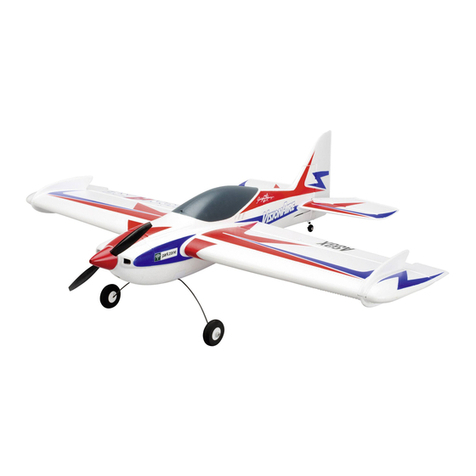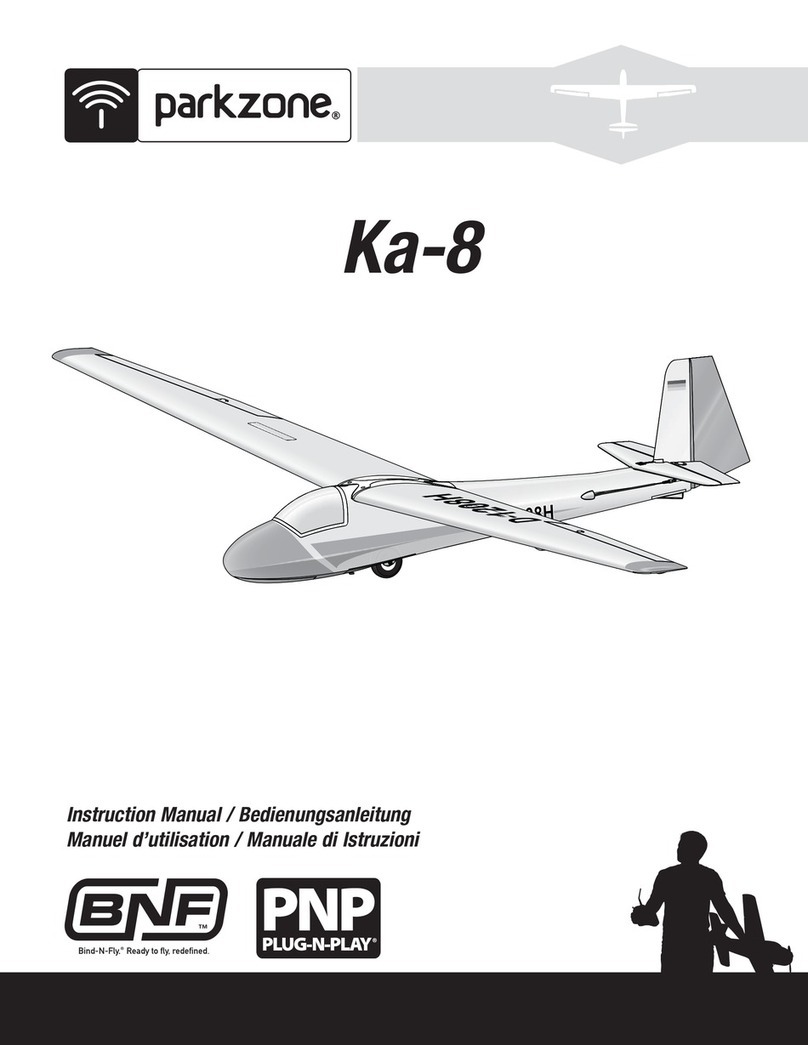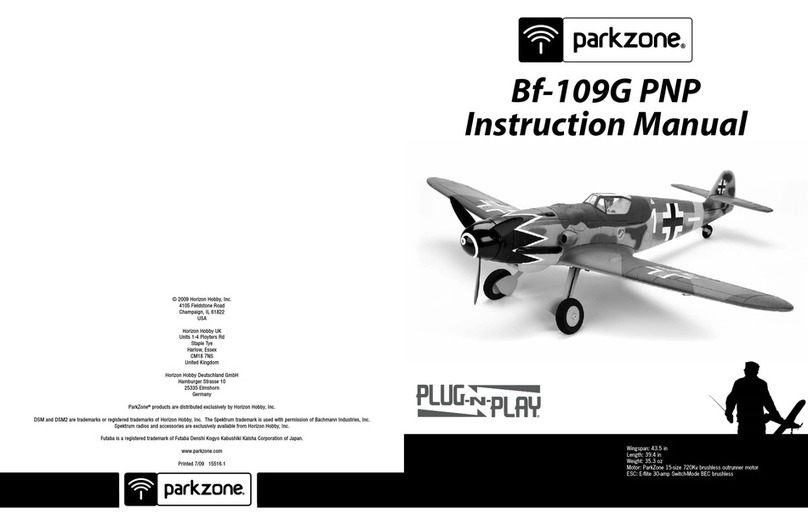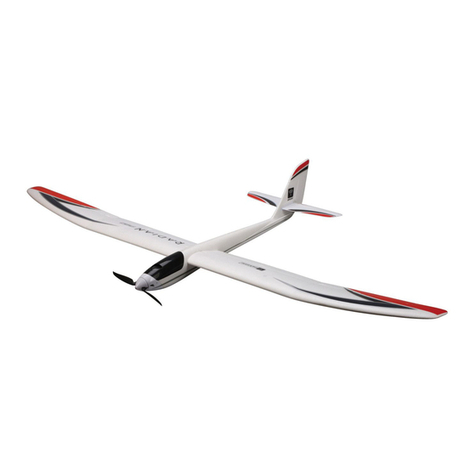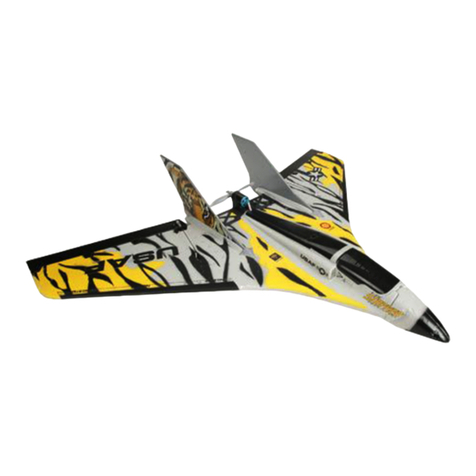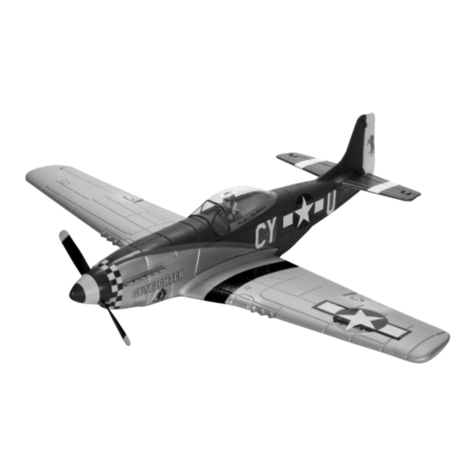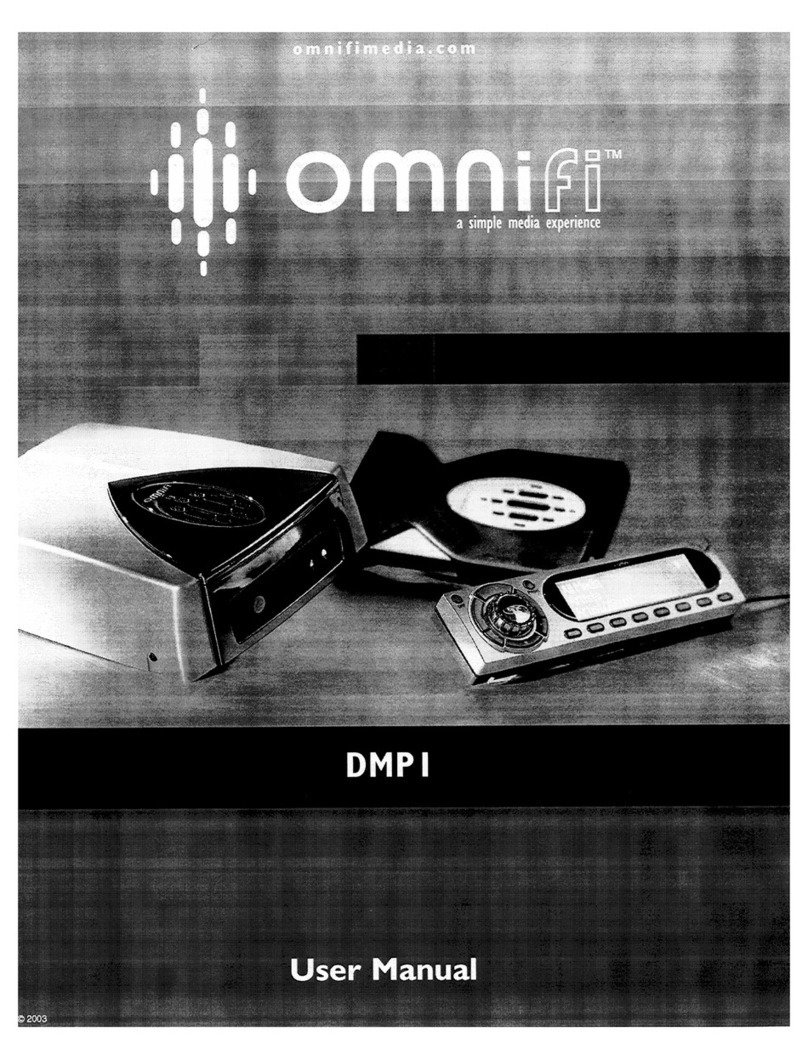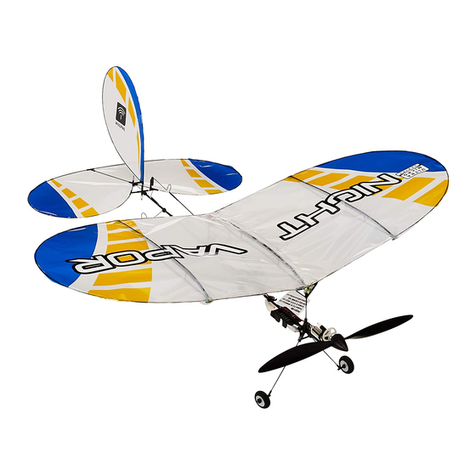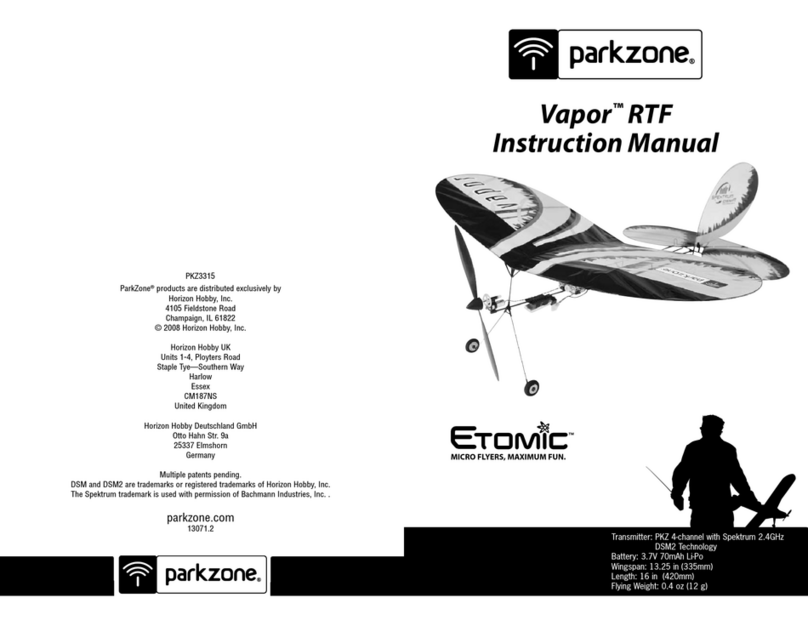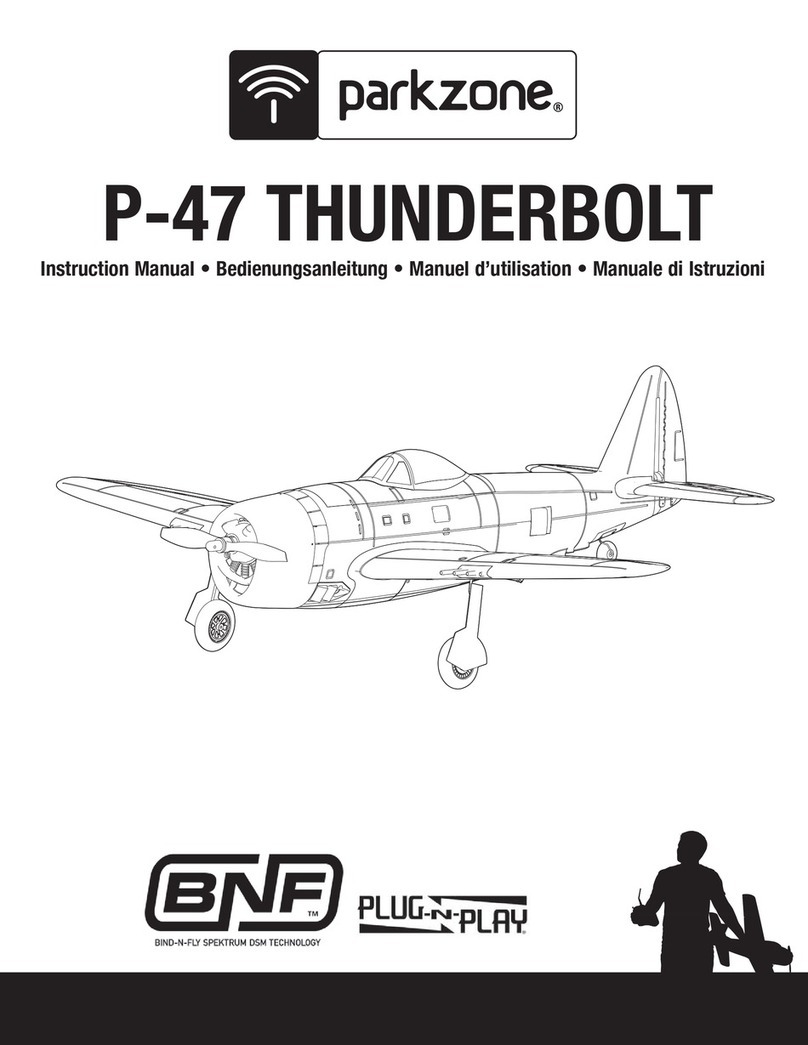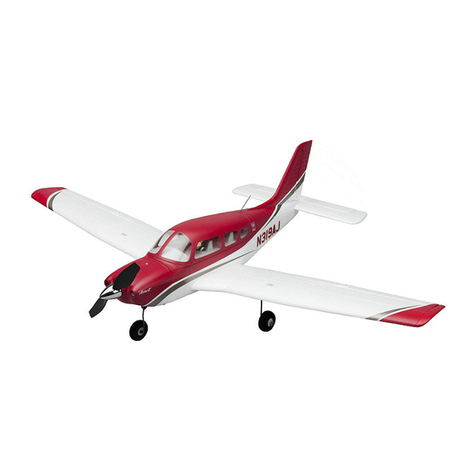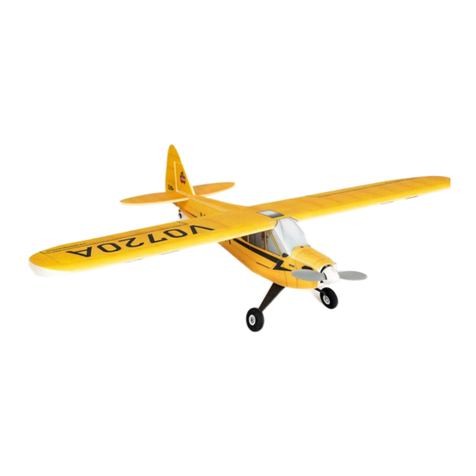1514
WARNING: For your safety, when checking the
startup function of the ESC or making programming
changes, please remove the propeller to prevent
any potential injury. You should always treat the
motor and propeller as live and dangerous,
remembering that it could start at any time, and
keep any body parts, clothing and tools clear of the
propeller arc. NEVER LEAVE THE BATTERY
CONNECTED WHEN NOT FLYING THE AIRCRAFT
AND ALWAYS REMOVE THE BATTERY FROM THE
MODEL BEFORE CHARGING AND WHEN
FINISHED FLYING.
When flying in hot weather, we recommend checking
on the condition of the ESC, battery, and motor after
each flight, and you may want to consider letting the
electronic components cool to near ambient
temperature between flights.
We also recommend throttle management when
running near maximum levels of current draw. It is
not recommended that you fly an entire flight at full
throttle. If this is done, it is possible to cause
permanent damage to your motor, battery, and ESC.
Using Your 10-Amp Pro Brushless Controller:
This controller is very simple to use, and for safety, will
not arm the motor until the throttle stick has been
held in the Idle/OFF position for more than 1 second.
The controller will indicate the soft cutoff voltage
setting every time you plug the battery in by first
emitting a low, long tone, to show startup. You will
then hear 2 (for 2-cell Li-Po) or 3 (for 3-cell Li-Po)
medium length, mid tones to indicate the cell count
(or 7 beeps if 70% Smart Cut is selected), helping you
to confirm the setting before every flight.
Connecting the ESC to the Motor:
The three wires from your motor connect to the three
female gold bullet connectors on the ESC. The order
of connection to the motor is not important; you can
plug any motor wire into any connector. If, when you
test the system, the motor runs backwards you can
simply unplug and switch any two of the motor wire
plugs connected to the ESC.
Mounting the ESC:
Choose a location that has good airflow and
offers good protection.
The plastic case area next to the small BEC heat sink is
designed to accept Velcro® or 2-sided tape. Do not
cover the heat sinks as this will greatly reduce their
effectiveness.
Mount the ESC with a combination of Velcro®,
2-sided foam tape, and/or tie wraps.
Starting Your Power System:
1. Turn on your transmitter and ensure the position
of the throttle stick is set to Idle/Off.
2. Plug in the flight pack to the controller and
listen for the tones to indicate voltage cutoff.
3. After the controller has indicated the cell
count, you will here a series of 3 medium
length rising tones to indicate the controller is
armed, and ready to fly.
4. When you move the throttle stick upward,
the motor will run. If you continue to move the
throttle stick upward to Full throttle (high
position), the motor will run faster. If you lower
the throttle stick below the start-up position,
the motor will stop running.
5. Check servo motion as part of your preflight
check. It is very important you make sure
linkages are free-moving with no binding.
Entering the Programming Mode:
1. With the battery disconnected from the
controller, and the transmitter turned on, first
move the throttle stick to full throttle (>1.7ms)
position. Leave it in this position and then
connect the battery to the controller.
2. Wait for 5 seconds, and the ESC will give two sets
of fast ringing tones to indicate you have
successfully entered the programming mode.
3. Once you hear these tones, move the stick to
center (between 1.4 and 1.6ms), and the
controller will beep 1 time; this indicates
menu item 1.
4. The controller will now wait 5 seconds for you
to make your selection; your programming
options are either full throttle (>1.7ms),
or idle (<1.3ms).
5. When you have made a valid selection the
control will beep once with a lower tone, and
you can move the stick back to center for the
next menu item (2 beeps, 3 beeps and so on). If
you do not make a selection within 5 seconds,
the controller will move to the next menu item.
6. Please note that if you do not need to
program every menu item, you can simply exit
the programming mode after you have made
the required selections. You can do this by
moving the throttle stick straight to Idle, after
making your selection, or leaving it in the Idle
position if you made a no selection (for
approximately 8 seconds), until you hear one
set of 3 medium length rising tones that
indicate the controller has armed the motor, or
by simply unplugging the battery.
Remember, when in the programming mode:
Full Throttle = Stick Up
Idle = Stick Down
The default settings (from the package) for your
E-flite® 10-Amp Pro ESC are as follows:
• 3S (9V) auto cutoff for Li-Po
• Brake Off
• 4-pole and greater timing (outrunner or
6-pole motors)
• Throttle input range set to Auto Select Mode
(1.2ms–1.8ms)
Programming Menu 1 – Voltage Cutoff:
Use this option to set the voltage at which the
controller will shut down the motor to prevent
damage to your battery, when it reaches the cutoff
voltage. You will know that your battery pack has
reached auto cutoff when you hear the motor
“pulse” repeatedly.
1. 3S Li-Po voltage cutoff – Full Throttle
2. 2S Li-Po or Ni-Cd/Ni-MH voltage cutoff – Idle
3. 70% Smart Cut soft cutoff (See below for
Smart Cut information)
NOTE: To access the 70% Smart Cut option, leave the stick at full throt-
tle for 7 seconds while in menu item 1, until 7 beeps are heard, then
continue through the program normally. This option will
activate the soft cutoff at 70% of startup voltage. For example, if your
pack measures 10.0 volts at startup, then the soft cut will occur at 7.0
volts. The Smart Cut option will check the startup voltage every time
you plug the battery into the controller, so beware of using
partially charged packs, as the system cannot protect your Li-Po
batteries if you are using Smart Cut and connect a partially
charged pack.
You will know your battery pack has reached soft auto
cutoff when you hear the motor “pulse” repeatedly.
We recommend you land your model as soon as you
hear the motor pulse (indicating the pack voltage has
dropped to the cutoff voltage level) to prevent
over-discharge of the Li-Po battery pack and to
prevent sudden power loss.
Programming Menu 2 – Braking:
This option gives you the choice to have the ESC stop
the propeller during flight (Brake on) or allow it to
windmill (Brake off). Use the brake-on option
for gliders.
1. Brake Off – Full Throttle (>1.7ms)
2. Brake On – Idle (<1.3ms)
Programming Menu 3 – Timing:
Please refer to your motor instructions and
specifications for an indication of the number of poles.
1. 4-pole and greater motors timing
mode – Full Throttle
2. 2-pole motors timing mode – Idle
Programming Menu 4 – Throttle Input Range:
This option is to allow for proper operation of the ESC
with many different radios on the market. Most radios,
and all the computer radios we have tested, work well
with the auto-set option, but some radios have a wider
output range, and may give a more linear response
with the 1.1 to 1.9ms range. If you feel there is too
much “dead” area in the stick movement near Full
Throttle, try adjusting the end points in your radio, or
change to the wider input range.
Be aware that if these settings are not correct, it may
be impossible to arm the controller. If this happens,
return the input range setting to the default auto
learning setting.
The auto setting option learns the minimum
position of your throttle (between 1.1 and 1.3ms) and
stores this value at each startup, and then adds a value
of 0.6ms for the full throttle setting.
1. Throttle Range 1.1ms to 1.9ms – Full Throttle
2. Auto Select – Idle
